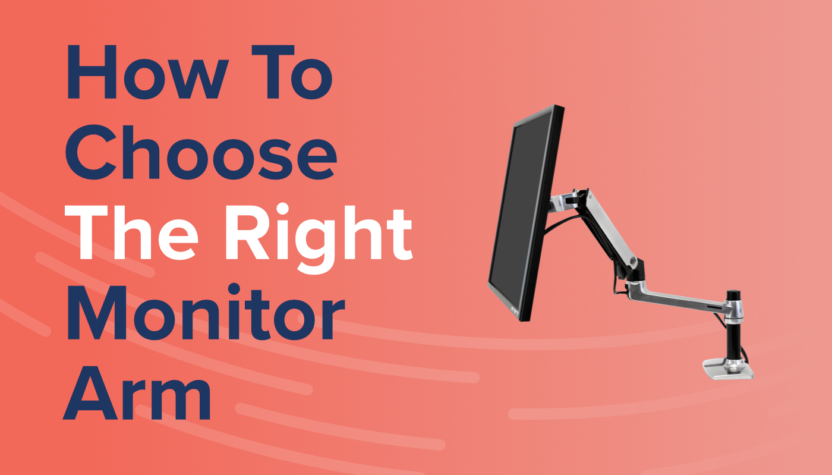Monitors come in all shapes and sizes. So when it comes to choosing a monitor arm, it can be challenging to know where to start.
The average office worker will spend 1,700 hours behind a screen each year. With all that time, it’s important to select a professional-grade monitor arm that helps keep you comfortable and productive. Here’s the top three things you should look for in monitor arms.

1. Compatibility
To start, select an arm based on the technology you have or will have. Ensure your monitors are VESA mountable. These four holes in the back of the monitor fit any brand of monitor arm.
Check the VESA mounting pattern
Ergotron pioneered VESA standards to help unify manufacturers of monitors and monitor arms, bringing compatibility across brands. Some monitor manufactures will place the VESA holes in irregular spots of the monitor. If your mounting pattern is higher on the monitor, this will limit the max height your monitor can be adjusted to, and vice VESA…err…vice versa.
The typical VESA mounting pattern for monitors is FDMI MIS-D, which is 75 x 75 or 100 x 100 mm. Monitors that are heavier than 30.8 lbs (14 kg) may require the FDMI MIS-E mounting pattern that can support up to 50 lbs (23.7 kg).
Check the weight
You can usually find the weight of your monitor by searching your manufacture and model number. You can also use our Mount Finder. If you don’t know the model number, it’s likely printed on a sticker on the back of the monitor.
Ensure the monitor doesn’t exceed the maximum weight of the monitor arm. This is especially important if you have an ultrawide display or multi-monitor configurations.
Check the max screen size
Some monitor stands may not offer the right amount of adjustability for extra-large displays if there’s not enough clearance below the monitor. If you’re looking for multi-monitor setups, too large of a display could cause the screens to not fit or hit each other.

2. Adjustment
Personalization is key when it comes to ergonomics and monitor arms. Imagine if cars didn’t have adjustable seats and steering wheels. It would be uncomfortable and likely dangerous. Poor ergonomics in a workspace can lead to chronic conditions or everyday aches and pains.
If you don’t know where to start, we have ergonomic tips to get you started to staying comfortable and productive while working in the office or remotely.
Lift
A monitor arm should be able to move up and down easily to fit your height. Your body can experience pain by sitting or standing at a workspace that isn’t designed for you.
If you have other height-adjustable furniture, monitor arms are especially important. Moving from sitting to standing can require further adjustment of your monitor that a static stand won’t provide.
Tilt
A monitor should be tilted back 10-20 degrees to reduce stress on your eyes—not perpendicular to your worksurface.
Pan
Being able to rotate your monitor arm around your workspace helps position the monitor for collaboration. When a co-worker or friend comes to your desk, this motion allows you to pivot the screen.
Depth
Flexible monitors add flexibility to your work. The ability to push your screen completely out of the way gives you more space for different projects or tasks. Combined with the ability to pan, you could mount the arm on the side of your desk, opening up more workspace.
Monitor rotation
Monitor rotation gives the ability to rotate your screen 90-degrees. Turning your display into portrait mode can help you see a document at full size or change up your workflow.

3. Quality
Purchasing a quality monitor arm will give you a better experience in everyday usability. From making sure your monitor doesn’t wobble to ensuring the safety of your workspace, quality matters.
Professional-grade
A professional-grade monitor arm will ensure your monitor is safe, secure, and in a comfortable position. It’s all about keeping you and your technology safe. High quality monitor arms go through rigorous testing to simulate use over a long period of time. Ergotron puts products through a 10,000-cycle movement test to ensure long-lasting quality.
Warranty
A warranty is a company’s promise of quality product. Look at the length of the warranty and keep in mind that monitors generally last longer than the computer. A monitor arm can last even longer than the monitor.
Footprint
High quality arms will often have modest sized bases. If the base is too small, it may be less secure. Too large, and the arm is less helpful to clear workspace.
Cable management
Good monitor arms also include cable management. This can help control the cable chaos around your desk and give you the Instagram-worthy photos.
Bonus tip: Ensure your cables have enough slack on your arm so that they don’t unplug or break when you move your monitor around.
Round-up
There’s a lot of factors to consider when purchasing a monitor arm. It’s important to invest in a quality, professional-grade monitor arm that has been tested to high standards.
If you’re still not sure which monitor arm is best for you, our Customer Care team is always on hand to help recommend a product for your space. You can also try out our Mount Finder to help narrow down our broad portfolio of professional-grade monitor arms.



